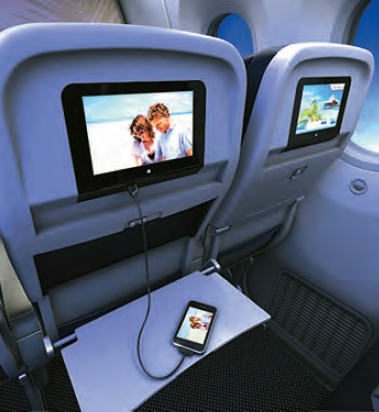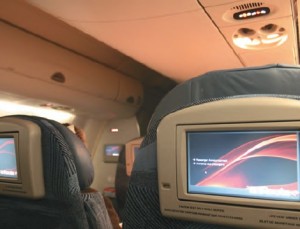Passenger Systems – Part 2
Passenger Accommodations, Systems & Services Explained – Part 2
In Part 1 of this series on passenger accommodations, we looked at the importance of ensuring proper function and operation of the systems designed to provide creature comforts to the paying passengers aboard our high-altitude, people-moving projectiles. Making sure that our bleary-eyed travelers have hot coffee, reading lights and audio-visual entertainment to while away the hours of mind-numbing boredom that is modern air travel, is an important aspect of maintaining a passenger-carrying aircraft. In a highly competitive market, it is essential that we cater to the needs of our customers, and ensure that certain cabin snags are addressed as a high priority maintenance item. Passenger loyalty is very difficult to earn, and is very easy to lose.
In terms of in-flight entertainment systems, great advances have occurred in recent years. The microchip and internet-inspired revolution in electronic communications and entertainment media have also slipped the surly bonds of earth, and have expanded the scope of audio/visual distractions available to the flying public in a huge way. Personal video display screens at each passenger seat allow for the selection of a wide array of entertainment choices, including film, broadcast television, games, Internet access, moving map displays and more. Safety and service announcements of both an audio and video nature can also be displayed on these “Smart Video Display Units” (SVDU) initiated manually by the flight crew or automatically in the event of an in-flight emergency.
At the dawn of the wide-body era of passenger flight, the challenge, from a technical perspective, was to provide multiple channels of audio entertainment to hundreds of passenger seats without using massive amounts of heavy electrical wiring. Three hundred seats, each wired for 24 channels of audio entertainment would mean such a weight load that we’d need to have JATO bottles installed on 747s! (which would be great fun to see, but the airlines would NEVER buy in). The solution was to use multiplexing (MUX) to carry multiple channels of audio to the seats, on a single conductor. Instead of each audio channel being wired individually, all of the audio is chopped into pulses (digitized) and sequentially sent along a single conductor to the seats in the passenger cabin. When the passenger selects a particular channel on their armrest-mounted passenger control unit (PCU) the de-multiplexing circuitry allows only the requested audio pulses to be routed to the listener’s headset and disregards all other pulses. This same technology can be used for other passenger accommodations such as reading lights, flight attendant call buttons, and even oxygen delivery.
The keys to multiplexing are in the synchronized switching of the multiplexer, which digitizes or chops the signals into pulses, and the de-multiplexer, which selects only the desired pulses and “re-assembles” them into a useable form, such as entertainment audio, an illuminated passenger reading light, or a flight attendant call signal. Even the operation of the flush motors can be controlled by a multiplexed system on a larger aircraft with multiple lavs.
Earlier-generation passenger entertainment systems (PES) allow passengers to use this multiplexed form of audio to listen to various recorded programs such as music, comedy and spoken word, as well as the soundtrack for THE in-flight movie. That is to say, a movie is shown, typically on a screen at the front of the passenger cabin, and all passengers can tune their PCUs to listen to the audio for that movie. The structure and operation of these MUX systems was such that the system provided access to the various channels of entertainment as they played in a continuous loop. For example, passengers listening to “Channel 5: Hits of the ‘70s” would all hear the same audio at the same time. The communication was unidirectional, from the source to the receivers.
Advancements in Ethernet technologies and the development of video and audio steaming allow newer-generation PES users (passengers) to select, on their own private SVDU, a wide variety of entertainment options, including a selection of films which they can control individually in terms of playback, fast-forward, pause, rewind, etc. The PES digital server units (DSU) act as information/entertainment providers, and the passenger’s SVDUs act as “clients”, receiving the streamed audio/visual content in an interactive (two-way) format through the Ethernet network.
Moving map displays are available on many PES, enabling the passengers to visually track the progress of their flight. Information from various avionics sources, such as air data computers and inertial reference/navigation systems provide input to what is commonly known as the airshow mapping feature of the PES. This enables the displaying of not only the moving map, but of flight information, such as airspeed, altitude, heading, time to destination, and so on. The maps themselves, in some cases, may boast high-resolution graphic imagery provided by an onboard data base.
Live television broadcasts and Internet access are becoming common features of passenger entertainment systems, as are interactive games. In fact, onboard communications with other passengers and interactive gaming amongst passengers are now offered as entertainment options on some flights.
 Of course, we, the flying public, know that it’s not all fun and games aboard the big ‘Buses and Boeings. Important information must be communicated to the passengers before, during and after each flight. Technical information, such as how to fasten and unfasten a seat belt, must be conveyed to passengers, even if they are enjoying the wide selection of two-star movies available to them. To this end, the passenger address (audio) and video address functions of the PES will override and disable the entertainment features of the PES, should a zone or full aircraft PA or VA announcement be initiated. These announcements may be made manually by the flight or cabin crew, or automatically, using prerecorded messages. A list of features available on a typical wide body PES would include:
Of course, we, the flying public, know that it’s not all fun and games aboard the big ‘Buses and Boeings. Important information must be communicated to the passengers before, during and after each flight. Technical information, such as how to fasten and unfasten a seat belt, must be conveyed to passengers, even if they are enjoying the wide selection of two-star movies available to them. To this end, the passenger address (audio) and video address functions of the PES will override and disable the entertainment features of the PES, should a zone or full aircraft PA or VA announcement be initiated. These announcements may be made manually by the flight or cabin crew, or automatically, using prerecorded messages. A list of features available on a typical wide body PES would include:
• Audio & Video On Demand (AVOD)
• Passenger Announcement (PA)
• Video Announcement (VA)
• Moving Map Display
• Pre-recorded Announcement Machine (PRAM)
• Boarding Music
• Games
• Built-In Test Equipment
As maintainers, there is perhaps no better system to illustrate the changing nature of our business, than the passenger entertainment system. From running wiring on a DC-4 to discussing digital servers and Ethernet cabling on a 777, the job of avionics technician has evolved immensely during my time in the industry. The emphasis on passenger satisfaction and the shift towards a greater understanding of computer hardware, software, protocols etc. means the aircraft maintainer of today must be trained in such a manner as to have greater soft skills as well as a wider scope of knowledge in terms of general technologies not directly associated with aviation-specific applications. Testing, troubleshooting, and often even repairing aircraft systems in today’s technological arena, is more about manipulation of software and user interfacing than it is about understanding the theory of flight.
Now, if I can just figure out how to save this article to my hard drive, without deleting it first…
Q: Name two sources of input data to the Airshow Mapping feature of a passenger entertainment system.
Answer to the question from the previous issue of AMU:
Q: What procedures should be followed when checking an aircraft’s galley oven receptacles?
A: Oven power receptacles can be checked for correct voltages and ground connections as well as signs of overheating and misalignment. Switch and timer functions should be verified to confirm that the appropriate power is delivered at the appropriate time.
About The Author
GORDON WALKER entered the avionics industry after graduation from Centennial College in 1980. His career with Nordair, Air Canada, CP Air, PWA, and ultimately Canadian Airlines took him to many remote corners of Canada. Since leaving the flight line to pursue a career as a college professor, Walker has continued to involve himself in the aviation/avionics industry, by serving on several CARAC Committees concerning the training and licensing of AMEs, being nominated to the CAMC Board of Directors, and being elected President of the National Training Association. (NTA).
View all articles by Gordon Walker.















































